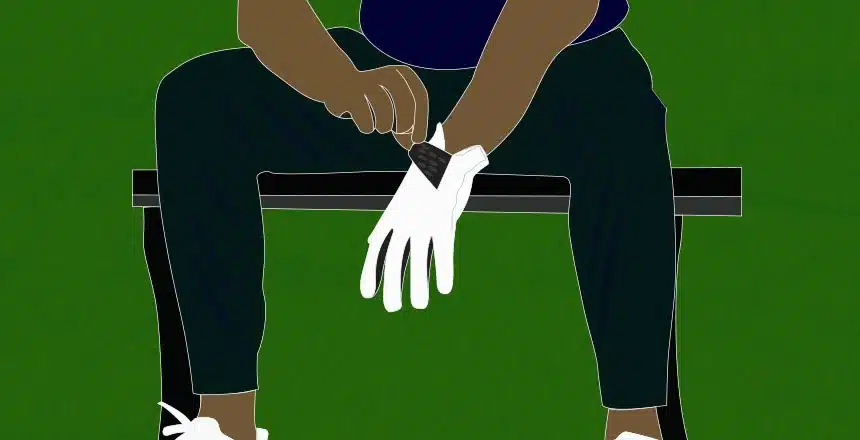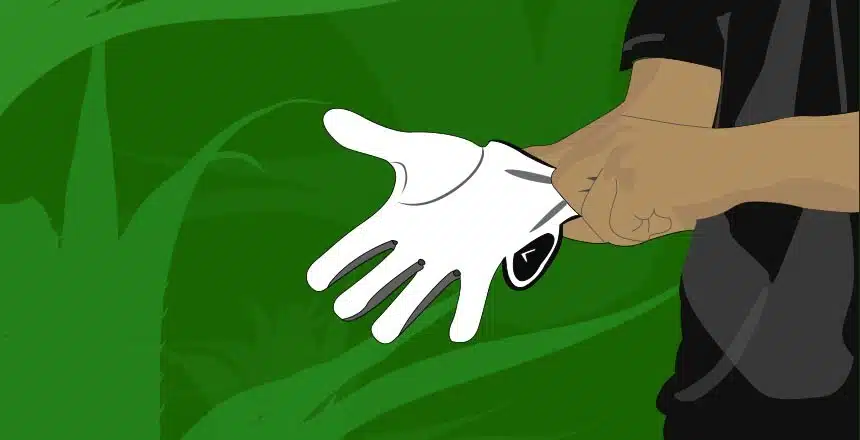The basics of golf gloves should be covered before anything else, yet they’re the most neglected piece of equipment in golf even though almost every golfer has on at least one glove. Not many even know which hand do you wear a golf glove on!
So allow me to cover the essentials through this post, which includes the correct hand for your golf glove along with getting the right size/fit of glove and choosing golf gloves based on weather conditions.
In This Post
Golf Glove On the Opposite Hand – Which Hand Is That?
If you’re a right-handed player, then that makes your left hand the opposite or weak one. So you should be wearing your glove on your left hand. And of course, if you’re left-handed, the golf glove then goes on the right hand.
But why is that? The logic here is very, very simple – your “top” i.e. lead or dominant hand placed on your golf club is the left one, so the grip of this hand is crucial. Thus, a right-handed golfer puts on his/her glove on the left hand, and the other way around for left-hand orientation.
And traditionally speaking, golfers wear just one glove. But there are some players, even PGA Tour pros, who opt for gloves on both hands. And then you also see many of them wearing a glove when hitting drivers and longer irons (basically, for full-swing shots). But then they remove the glove when putting and for shots around the green.
The explanation for that is just one word – FEEL. This particular factor is priority #1 when it comes to the short game. And golf gloves, needless to say, hold back that feel on these kinds of shots.
Why Is It Important to Wear Golf Glove?

To be honest, the reasons why golf gloves are getting so popular and why wearing one is so important now are as clear as a bright, sunny day!
#1 It Improves Your Golf Grip
Correct golf grip 101 is all about acing the proper finger and hand positioning (because your grip, after all, is the only point of contact between you and the club). So the glove, at this point, keeps that golf club of yours from slipping off your fingers/hands. It’s there to add the much-needed ‘extra’ friction!
#2 It Protects Your Hands
Another very common reason for wearing a glove in golf is that it protects your hands. Protection against what though? If you’ve been playing for too long, then you probably know the painful pressure or sting felt in your hands when golfing for the first time after an uneventful or long winter.
Developing callouses on the hands is also something that happens if you play golf very frequently. One look at former World #1 professional golfer Jordan Spieth’s hands and you’ll know! Aside from obviously being painful and also frustrating to deal with, these callouses can damage your game too. Enter the best golf gloves to save the day!
And now you might be wondering.. why wear just one glove then? Well, because it’s your opposite or weak hand that does more of that gripping of the golf club. So it’s mostly the left hand (for right-handed golfers) that deserves the highest level of protection.
Does Wearing A Golf Glove Really Make Any Difference?
It will and does make a real difference when it comes to protecting your hand from developing blisters, callouses, etc. due to repeatedly swinging your golf club.
Gloves, after all, have a tackier texture or feel than skin. And that extra tackiness in the grip is what provides protection by preventing the turning of the club in your hand. So you get a little bit more friction, which always is very useful as a part of your golf grip.
The Right Size/Fit of Golf Gloves
There are golf gloves for kids even, and there’s a valid, plausible reason for that. A glove is never supposed to be either too tight (cause then it’s constrictive) or too loose (you don’t want your hand to move around inside, right?) as that is sure to mess with the grip.
The right size consists of a snug yet comfortable fit across your palm with no loose ends at the tips of your fingers. At the same time, the glove shouldn’t feel too tight, like it’s restricting blood circulation.
The best way to make sure you’ve got the right fit is to stretch those fingers. Close your fist and check if the glove is over-stretching or pulling.
Also important to understand is that not all models and brands follow the same sizing/fitting standards. For example, FootJoy golf gloves are best known for their exceptional fit and super-comfortable feel. But that doesn’t mean you’re going to get the same results from gloves of the same size from another brand.
Women’s Golf Gloves
The specific sizing of the best golf gloves for women is perfect because, believe it or not, men and women are not built the same way.
Traditionally, golf gloves, on the surface of things, seem gender-neutral. However, that doesn’t work for women with smaller hands than men. There are indeed Petite-sized golf clubs for women, then why not gloves too!
Golf Gloves Based On Weather Conditions
Cabretta leather gloves are perfect for when the weather is pleasantly bright and sunny. But even the soft leather kind (manufactured by FootJoy, Callaway, TaylorMade, Ping, etc.) offers the most comfortable feel and an optimal level of tackiness on the grip of your golf club.
The latter, however, is not the most weather-resistant or durable, unlike the former which gives you exceptional feel and feedback through your whole golf swing sequence and also on your shorter shots.
There are golf gloves made of synthetic (all-weather-resistant) material as well. These are certainly more durable, tougher, and longer-lasting in comparison to leather. But then the best wet weather golf gloves for when it’s pouring rain are made of leather indeed. Leather here is exactly what enhances the grip in wet conditions.
What about golf gloves for winter? These are gloves specifically designed for conditions that consist of a decline in temperature. And they do a wonderful job of keeping those precious golfing hands of yours warm so you can still play despite the chilly weather.
Conclusion
If you’re a right-handed golfer, lucky for you, you’re most likely to find a size that fits the most comfortably at every sporting goods or golf store. But not so lucky in case you happen to be a leftie! The former is more widely available than the latter.
Whatever the case, never skip wearing a golf glove, especially if you hit the course regularly. Gloves not only improve your grip but also protect your hands (so no more painful blisters to deal with even if you play more frequently).
And once again, whatever the case, always choose a golf glove that fits properly – not too tight nor too loose!
Lastly, golf glove care is also a must since this piece of golfing gear wears out pretty quickly. But you can increase its longevity by taking simple measures. Such as not yanking off the glove from your fingers. And also making it a point to store the glove in a separate compartment in your golf bag instead of just dumping it with your golf balls and tees.

